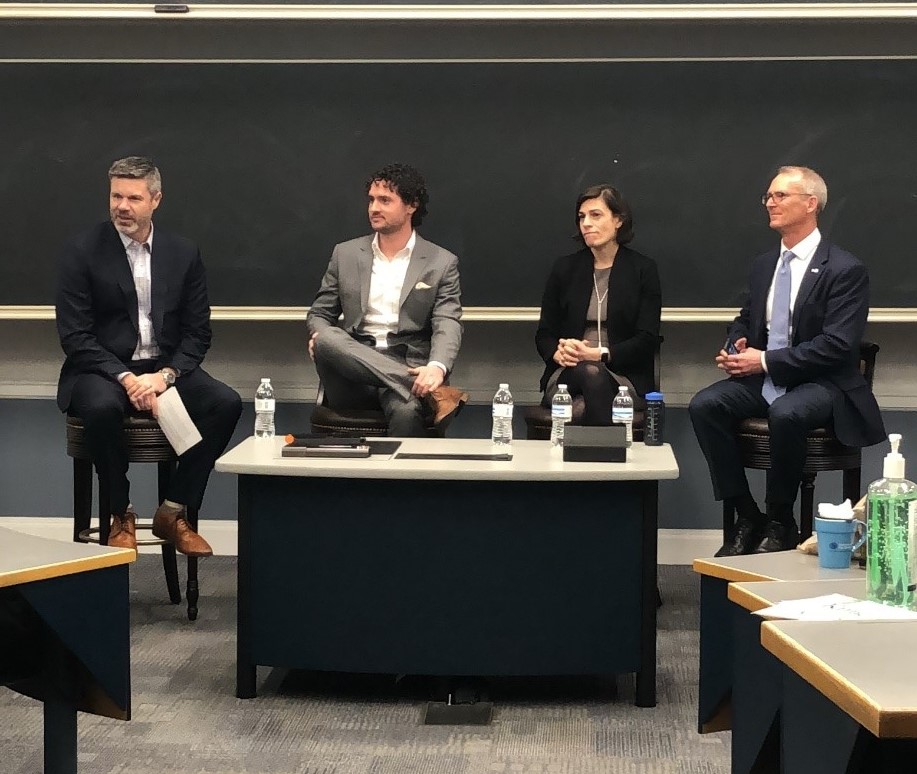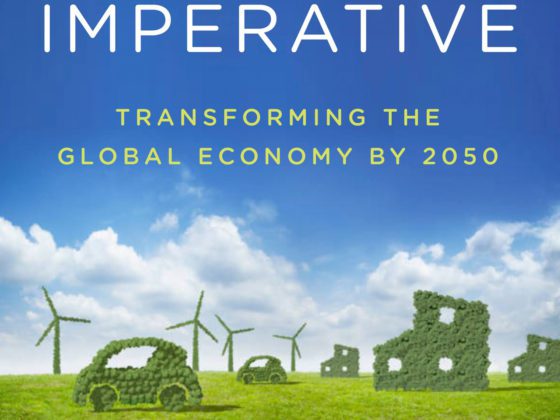What does the clean energy future look like and how can we accelerate the transition from fossil fuels to renewable energy sources? These are some of the questions discussed during a Clean Energy panel hosted by Net Impact at Darden on February 5, 2018.
The panel was moderated by Professor Mike Lenox, Faculty Director of the Business Innovation and Climate Change Initiative, and included experts from the private and public sectors, including: Devin Welch, Sun Tribe Solar; Chrissa Pagitsas, Fannie Mae; and Bob Inglis, Executive Director, RepublicEN, and former U.S. Congressman.
Let’s start with some numbers. The growth of solar is nothing short of incredible. In the U.S., solar has experienced an average annual growth rate of 68% in the last 10 years. Globally, solar capacity has doubled since 2014. Increasing global demand has driven down prices and in some regions installation costs are falling below $0.02/kWh. Storage, which is critical to grid balancing, is following the same cost curve as solar and is expected to be cost effective within four years.
Will the new solar tariff recently approved by President Trump threaten growth in the U.S.? According to Welch, it depends on the market segment. The tariff will result in a small increase (3%) in residential solar installation costs but for utilities where the panels represent 45% of the total cost, the impact will be more significant. We will see a lull in solar deployment, and jobs will be lost, but the tariff is structured in such a way that the percentage declines over four years. Utility-scale projects are being delayed, but not cancelled. In the meantime, rising global demand in solar cells will continue to push costs down. In preparation for the tariff, many companies began importing hundreds of megawatts of panels, which will also allow projects to continue. In the end, solar will emerge in good shape.
Of course, solar has benefited greatly from investment tax credits. Will it survive if those incentives go away? Welch’s answer is yes. In fact, the solar industry has been rapidly decoupling its growth from financial incentives. But just because we don’t need incentives doesn’t mean that there aren’t other regulatory challenges ahead. The core mission of utilities for 100 years has been to make electricity cheap and accessible, and they have fulfilled that mission. But now we are asking more of the electric grid and more of utilities. How do we create the space for utilities to evolve into a business model needed to provide new electricity services? We need an electric grid and utility infrastructure that can more nimbly respond to the needs of a more dynamic energy market. Our work is still cut out for us.
How do we facilitate solar deployment, especially in market segments like multi-family housing where incentives are split between renters and building owner? Fannie Mae is creating incentives that allow for energy and water efficiency investments at the financing stage. But the key is to keep things simple for the mortgage originators. Pagitsas noted the challenge of transparency, in that the building owner doesn’t have access to rental unit consumption data that they can then use to improve building performance. In absence of regulatory forces, utility companies could be convened to develop standards regarding data transparency that will benefit all parties.
And don’t underestimate the power of global corporations. Here in Virginia, Dominion Power created a brand new rate structure for Amazon to entice them to build in the state. Recently Facebook announced that it would invest $1 billion in Virginia; of that money, $250 million is earmarked for renewable energy purchases. Being green is becoming a part of doing business and companies that don’t invest in reducing their carbon footprint are being looked at as risky business.
Then there’s Washington. Is there any hope for federal support? We are seeing a shift in Republicans with regard to acceptance that climate change is a real issue and solutions are needed to address the potential impacts. RepublicEN is trying to expand this base of support with the message that free enterprise can deliver the innovation needed to solve climate change. Inglis believes that if you level the playing field and eliminate subsidies across the board, then we can see the true cost of all types of fuel use. For renewables that cost is $0. Free-market solutions seem to be well aligned with traditionally conservative values.
But what we are up against is unprecedented. Removal of the words “climate change” on government agency websites implies that the problem just doesn’t exist. While one might argue what policies should be considered, I thought we were past the debate over whether climate change is happening. We seem to be moving backwards, not just with regard to climate policy but in technology innovation. Supporting new, cutting edge and sustainable technologies will secure our energy future and keep us competitive with the rest of the world. The encouraging news is that in lieu of federal government leadership, states, businesses, and the investment community do see the value in clean technologies and are initiating new programs.
There is another important stakeholder that we are missing from the discussion: the consumer. How do we bring along the skeptics? According to Inglis, the challenge is convincing the public that change is good, not disruptive, and that they will benefit, not suffer, from clean energy progress. For example, rural communities have much to gain from the job creation associated with clean energy adoption.
But Rome wasn’t built in a day, and neither will the clean energy future. Pagitsas noted that it took eight years for Fannie Mae’s Green Financing business to reach the $32B investment mark. Change takes time and in many cases you are the 1% minority in an organization – how do you bring along the rest of the 99% when they don’t want change? Just as there is a need for entrepreneurs to disrupt the market there is also a need for intrapreneurship.
At the end of the day, the ability to influence policymakers could come down to terminology. This is particularly true of the Republican base. “Energy optimism” is what conservatives need to hear not predictions of doom and gloom. In many cases innovation grows out of accountability. In the horse carriage days of the 1800s, if New York City told residents to “scoop your own manure”, the automobile might have been invented much sooner. Bob Ingils simplifies it “Pay for what you take in the salad bar of life, and you will carefully take from that bar”.
Bring me a salad plate, I’m ready!


